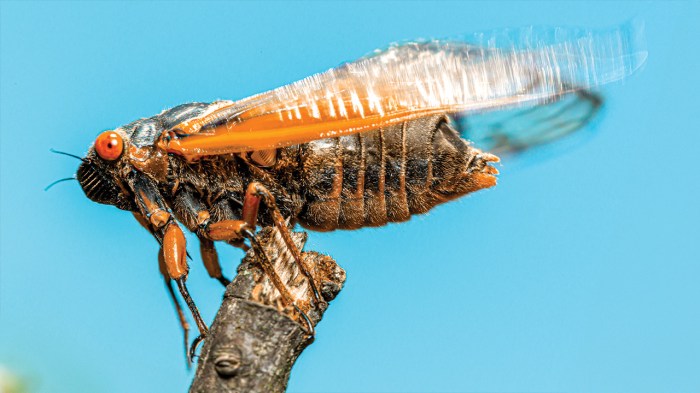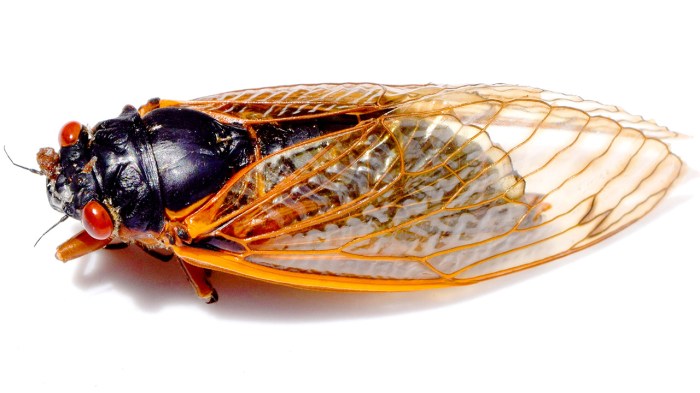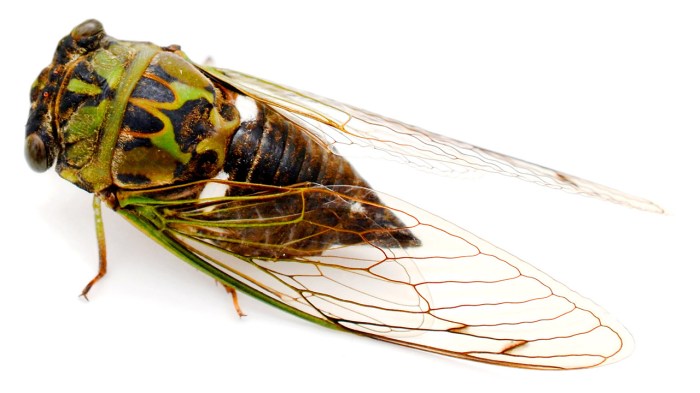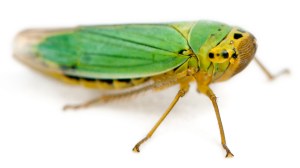Cicadas: Making Summer Magical

If you’ve never seen cicadas, you’ve definitely heard them. These chunky, bulgy-eyed, large-winged insects have an ear-splitting sound.
The cicada (say: suh-KAA-duh or suh-KAY-duh) is a bug that people either love or hate. We fall into the love category, knowing their rhythmic songs are a sure sign of summer.
CICADAS JOURNEY FROM GROUND TO SURFACE
There are more than 3,000 species of cicadas worldwide, with about 170 species in the U.S. Cicadas live in temperate or tropical regions of all continents except Antarctica. Most are in forested areas and rely on trees for survival. A few species inhabit prairies or grasslands.
Most are an inch or two long, but the smallest in North America is the 1/2-inch aridland cicada in the Southwest. The largest cicada in the world lives in Southeast Asia, is 3 inches long and has an 8-inch wingspan!
Cicadas live most of their lives underground in their immature stage, called a nymph. They feed on liquid from plant roots, but they don’t cause much harm to the plants. As adults, they still have only a liquid diet of plant sap. After their nymph stage is over, they burrow up through the ground to the surface.
After crawling to find a solid object to climb, such as a tree, fence or car tire (anything touching the ground is fair game!), they begin to molt, which takes about an hour. Their skin cracks open and the new adult crawls out, with big, strong wings. You might have seen their husky brown skins left behind.

Periodical cicadas have the longest life cycle of any insect.
SING OUT LOUD
Cicadas typically live only four to six weeks, so they have to get noticed fast to mate. The best way to do that is by being loud! Males sing, or drum, from trees to attract females. The loudest of the bunch is an African cicada, coming in at 107 decibels — almost as loud as a chainsaw! Several North American species are nearly as loud. They make this sound with structures called tymbal organs, located on their abdomen. There is space around these organs where the air vibrates to make sounds.
The males also drum when in danger. Cicadas are harmless. They don’t bite or sting and they don’t have venom or poison, so their only defense is screaming loudly. This is a response to make a predator leave or drop them. If you approach a tree when a cicada is singing, it will typically get quiet, but if you pick it up, you’ll get an earful!

Annual cicada
CICADA MAGIC
Most cicadas are what biologists call annual cicadas. These live only 1 to 5 years, mostly underground. The few remaining species are called periodical cicadas, which come out of the ground in huge numbers.
Worldwide, there are only seven species of periodical cicadas, found solely in the eastern and central U.S. These live for many years underground — in periods of 13 or 17 years — before emerging. There are 15 different cycles or “broods” of periodical cicadas. Each brood can be made up of several species.
Scientists aren’t sure why periodical cicadas have this odd life cycle, but it might be due to long periods of cold thousands of years ago. In addition, the range map of the 17-year broods matches closely with glacier movements of the last Ice Age. Why periodical cicadas still follow these patterns today is unknown. Maybe it makes it less likely that predators will anticipate when there is an eruption. Regardless of why, periodical cicadas’ life cycle is so amazing that biologists placed them in the genus Magicicada. Indeed, they are magical!
By creating a surge of millions or even billions at one time, emerging all at once gives periodical broods a big advantage. This overwhelms predators and makes it impossible for all the cicadas to be eaten, ensuring plenty survive to reproduce.
If there are no periodical cicadas where you live, don’t fret! There are many annual species in your area. Just keep an ear out for their drumming. Different species have different sounds that can be learned, just like bird songs. Getting to know cicadas is a great way to introduce yourself to the amazing world of insects!
2024 Cicadapocalypse!

In 2024 there has been a special emergence of two broods of periodical cicadas (13- and 17-year) in parts of the U.S. The last time these two broods — Brood XIX and Brood XIII — erupted at the same time was in 1803, when Thomas Jefferson was president!
There are an incredible number of periodical cicadas around. Biologists predict there could be a trillion. Some are even calling this event a “cicadapocalypse”!
4 FAST FACTS ABOUT CICADAS
1. Some places might have so many cicadas that people have to shovel the carcasses from roads! This happened in Chicago 17 years ago when Brood XIII last emerged.

Green leafhopper
2. Cicadas are not locusts, which are a type of grasshopper. Cicadas are most closely related to leafhoppers, treehoppers and spittlebugs, although much larger.
3. Periodical cicadas are somewhat smaller and darker than annuals and have bright red eyes. Annuals are typically more green and brown overall with greenish to brownish eyes.
4. A main predator of cicadas is the cicada-killer wasp. The females paralyze and carry off live cicadas to their burrows, where larvae feed on them. You might see one of these wasps dragging a stunned cicada. Watch long enough and you might find the entrance to their several-foot-long burrows.
Bats and birds are their specialties, but wildlife biologists Selena Birgit Kiser and Mark Kiser love all species of critters. Both have worked for the State of Florida and previously worked for Bat Conservation International on such programs as the Great Florida Birding and Wildlife Trail and the North American Bat House Research Project.
Leave a Comment